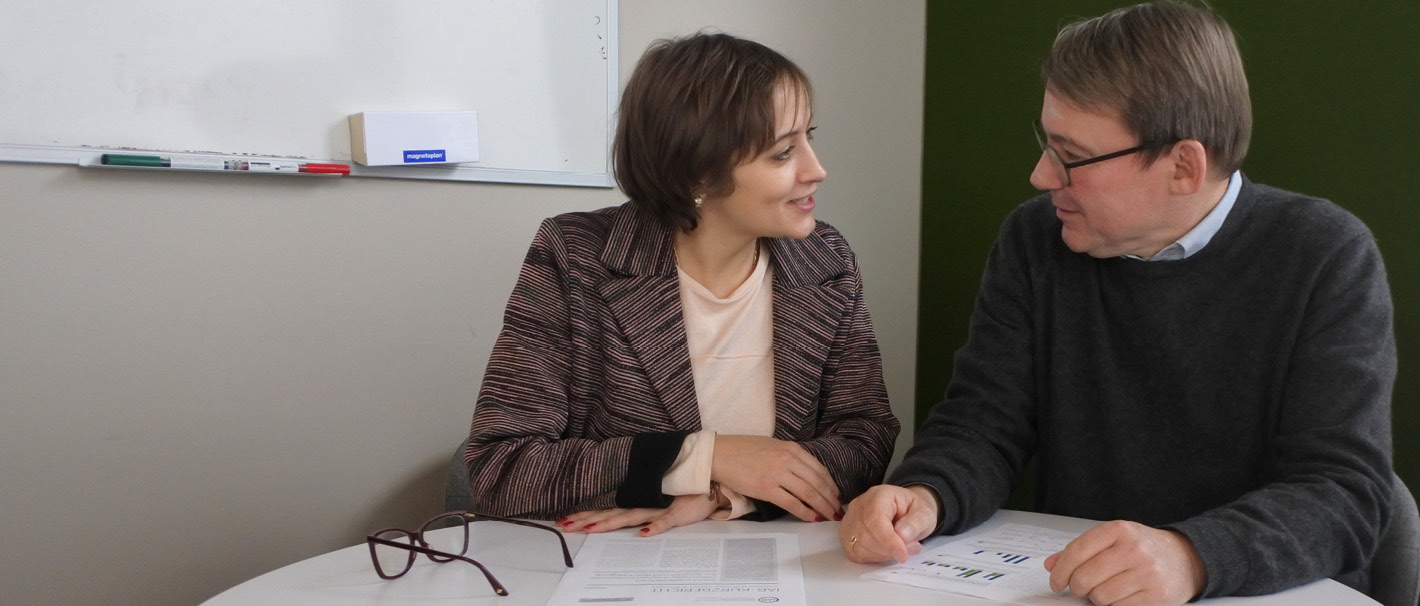22. March 2019 | Interviews
“The labour market integration of refugees is working out much better than we expected.” An interview with Herbert Brücker and Yuliya Kosyakova

Is the labour market integration of refugees in Germany going according to plan?
In October 2018, 35 percent of the refugee population in working age which has arrived since the beginning of 2015 were in employment. This means that labour market integration has proceeded a little faster than we have observed in the previous cohorts of refugees in Germany. In light of the fact that the prerequisites for refugees who came here in 2015 and after have in some ways become less favourable than in the past, this is a truly remarkable result. At least in this regard, the labour market integration of refugees is working out much better than we expected.
Why did the prerequisites for integration used to be better than they are today?
There are three critical factors: Firstly, the consequences of war and persecution are particularly traumatic for many refugees such as those from Syria. The refugee routes are more dangerous, too. We are therefore observing a clearly increased risk of post-traumatic stress disorder, probably more severe than in earlier cohorts. That impedes integration, of course. Secondly, a lot of people arrived during a short period of time, and they all must be accommodated and taken care of by the state. That is why registration, asylum procedures, and decentralised accommodation arrangements have taken longer than in the past. That is another impeding factor to integration. And thirdly, the education prerequisites of the newly immigrated refugees are less favourable than in the past, especially in the field of professional qualifications. Those differences are not too grave, however. We assign more weight to the first two factors.
The favourable labour market situation has probably helped.
Then again, the demand for labour is high at the moment. How does this fact affect the labour market integration of refugees? And what would be the repercussions of a recession?
The favourable labour market situation has certainly helped. As we can observe, refugees residing in labour market districts with lower unemployment rates and a prospering economy have better labour market chances and opportunities than those residing in economically underdeveloped regions. A recession would therefore surely cause damage. But there is no way to put an exact figure on it. And other groups would be negatively affected by a recession, too.
What is the biggest obstacle to the labour market integration of refugees?
Compared to other migrants, refugees are less prepared for the labour market integration and face a bunch of challenges. For example, hardly anyone of the refugees spoke German when they first arrived here. They are subject to prohibition of employment during the first phase. During the asylum procedure and in some way even after it, their residence status is legally uncertain. That, in turn, prevents the refugees from investing in language skills, for example, or educational or vocational qualification. And it may keep companies from hiring refugees.
There are a great number of obstacles.
Are there any other obstacles?
Yes. For administrative reasons, refugees are dispersed across all regions in Germany. In economic terms, this increases the costs of seeking jobs and information on labour market integration and makes it harder for them to use a personal network in their job search. Moreover, every third refugee household has children, and very often infants. This has a particular impact on the labour market integration of refugee women. The lack, or inadequacy, of childcare options is playing an important role here. In a nutshell: We are dealing with a number of obstacles hindering labour market integration, especially during the early phase after immigration.
The study concludes that “the possibilities of language promotion, integration in the educational and vocational training system, and labour market integration have not been exhausted yet.” To what extent does that hold?
Currently, about one third of refugees speak German well or very well, one third have an intermediate level, and the remaining third have no or only little knowledge of the German language. Approximately half of the refugees participated in or completed the most important language programme of the Federal Government, the integration courses, in the second half of 2017; the other half, however, have not yet done so. In our opinion, faster and more comprehensive language promotion could have made integration easier at all levels of society.
Politics could still do more.
And where are the deficits regarding integration in the educational system?
About one tenth of refugees attended an educational institution in the second half of 2017 or were in vocational training. That is a rather small share given the high educational aspirations of refugees and the backlog in education, particularly in the area of professional qualifications. On the one hand, lower participation in education is driven by the lack of prerequisites to attend a vocational school or university such as language proficiency, general education, and professional background. On the other hand, the range of offers to create these prerequisites and to adapt the existing educational prerequisites to the requirements in Germany is not sufficient. The politics could do more in this regard: pre-educational measures, tailored educational and vocational programmes. Schools, vocational schools, universities, and companies would have to invest more. And of course, there is more potential in job placement and labour market policy to promote labour market integration.
Can you give us an example?
Our findings indicate that professionally oriented courses such as the ESF programmes offered by the Federal Office for Migration and Refugees or the programmes offered by the Federal Employment Agency are particularly effective. Such integration measures increase the likelihood of finding gainful employment and contribute to higher wages. These offers should be developed and extended more.
Are there any findings which surprised you?
We expected lower employment rates for refugees whose asylum applications were rejected and for those who are still waiting for the decisions on their applications compared to those who have received a protection status. This is, however, not the case.
Why not?
Several factors play into this. Firstly, refugees with recognised protection status show increased participation rates in integration courses and labour market policy programmes. While this will probably facilitate labour market integration in the long run, the short-term result is a lock-in effect, because the course or programme participants are not available to the labour market, or only to a limited extent. Secondly, we observe that asylum-seekers with rejected asylum applications are particularly fast to integrate themselves in the labour market. A possible reason for this observation is their high incentives to prevent deportation or to make some quick money while they still can. At the same time, that group appears to earn less than other refugees. So they are obviously integrated in the labour market faster, but they have worse jobs.
Photo by Kurt Pogoda, IAB
Literature
Brücker, Herbert; Croisier, Johannes; Kosyakova, Yuliya; Kröger, Hannes; Pietrantuono, Giuseppe; Rother, Nina; Schupp, Jürgen (2019): Second wawe of the IAB-BAMF-SOEP Survey: Language skills and employment rate of refugees improving with time. (IAB-Kurzbericht, 03/2019 (en)), Nürnberg, 15 pp.
Schludi, MartinHerbert Brücker; Yuliya Kosyakova (2019): “The labour market integration of refugees is working out much better than we expected.” An interview with Herbert Brücker and Yuliya Kosyakova, In: IAB-Forum 22nd of March 2019, https://www.iab-forum.de/en/the-labour-market-integration-of-refugees-is-working-out-much-better-than-we-expected-an-interview-with-herbert-bruecker-and-yuliya-kosyakova/, Retrieved: 2nd of April 2025
Diese Publikation ist unter folgender Creative-Commons-Lizenz veröffentlicht: Namensnennung – Weitergabe unter gleichen Bedingungen 4.0 International (CC BY-SA 4.0): https://creativecommons.org/licenses/by-sa/4.0/deed.de
Authors:
- Martin Schludi

 Dr Martin Schludi is scientific editor in the department "Media and Communication" at the IAB.
Dr Martin Schludi is scientific editor in the department "Media and Communication" at the IAB.